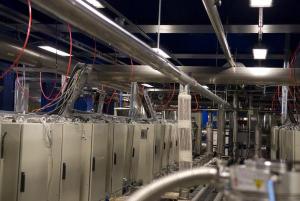
The ICARUS detector will be used to study neutrino oscillations at Fermilab starting in 2018. Photo: Fermilab
WASHINGTON — Neutrinos are extremely shy particles. A single one could sail through a block of lead 10 times the size of our galaxy without fuss or fanfare. In fact, when their existence was first proposed, scientists doubted they would ever be observed. But almost 85 years later, three types of neutrinos — the electron neutrino, muon neutrino and tau neutrino — have been discovered, and physicists are hard at work trying to find a fourth, even shyer, neutrino.
“We have to ask the question: Do we really have just three kinds of neutrinos or do we have other kinds that we haven’t discovered?” said Kam-Biu Luk, a physicist at the University of California, Berkeley, during a symposium at the American Association for the Advancement of Science (AAAS) annual meeting.
Neutrino is an Italian-derived word that essentially means “something small and neutral.” These particles are more than one million times lighter than the electron. Each type of known neutrino can change into any of the others while traveling through matter such as the sun, Earth’s atmosphere, or the human body. This phenomenon is called neutrino oscillation, and physicists were shocked when they first saw it happening.
The Standard Model, which describes mathematically the known particles and forces in the universe, says the neutrino is massless. But for neutrino oscillations to be possible, the elusive particles had to have mass.
“That tells us that our conventional wisdom for the last 50 years is totally wrong,” Luk said.
Experimental results point to the existence of a fourth kind of neutrino. Scientists at the Reactor Experiment for Neutrino Oscillations (RENO) in South Korea, for example, calculated how many electron antineutrinos — particles formed when a neutron decays — should show up on their detector. But the number seen was much lower than expected: Some electron antineutrinos had gone missing. That deficit could be explained if some of the electron antineutrinos were transforming into a different, undetectable entity, dubbed sterile neutrinos.
If they exist, these sterile neutrinos would be even harder to find than normal neutrinos. To understand why requires an understanding of the forces with which neutrinos interact with other forms of matter. Electron neutrinos, muon neutrinos and tau neutrinos experience gravitational force — but this effect is much less for these very small particles than it is for larger objects. Importantly — as this what aided their detection — they also interact through a force called weak force, which is responsible for the decay of subatomic particles and processes such as nuclear fission. Unlike the known neutrinos, however, sterile neutrinos have not been detected during any subatomic decay processes, and their absence is an indication that they do not have weak force interactions, but instead, only gravitational force. But since the masses of the sterile neutrinos would be so tiny, those gravitational effects would be impossible to observe. The only way to verify their existence, then, would be through their effect on neutrino oscillation — when one type of neutrino changes into another.
New experiments underway to sleuth out these ghostly particles include some using the 760-ton ICARUS detector, which is scheduled to begin operations at Fermilab in 2018. ICARUS will be used to observe neutrinos produced by an accelerator colliding with molecules of liquid argon. The Standard Model, a longstanding theory of fundamental particles and their interaction, offers precise predictions of how many of each kind of neutrinos will be seen. The presence of more electron neutrinos than predicted will offer strong evidence that sterile neutrinos exist.
But the search still has a long way to go.
"It will take about three years of data-taking by ICARUS to be able to get the statistical significance we need to start saying whether these are actually sterile neutrinos," said Fermilab physicist Peter Wilson, who also spoke at the symposium.
Meanwhile, cosmologists are trying to figure out how many sterile neutrinos might exist in the universe, and whether they might be one of the particle types that make up the mysterious dark matter astronomers know represents 27 percent of the universe.
“Our universe provides a very large laboratory to test the fundamental properties [of sterile neutrinos],” said Olga Mena Requejo, an astrophysicist from the University of Valencia, Spain, during the symposium.
And what if the experiments don’t reveal the existence of sterile neutrinos?
That would perhaps be the most exciting result of all. Physicists would need to propose a new particle or even a whole new model to explain the anomalies they see in their experiments, taking science in a direction that, right now, no one can predict.
Danna Oassis is a senior physics student at the Universidad Nacional Autónoma de México (UNAM), where she works in the communications department of the Instituto de Física UNAM. She enjoys traveling, running and baking. Reach her at danna@fisica.unam.mx
